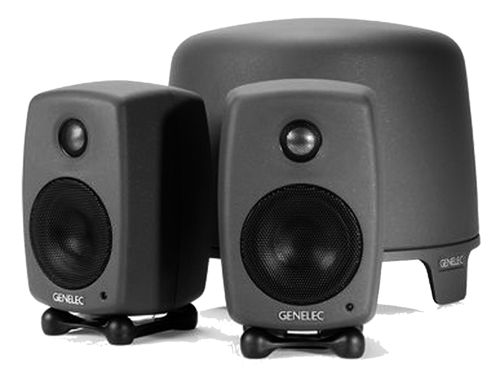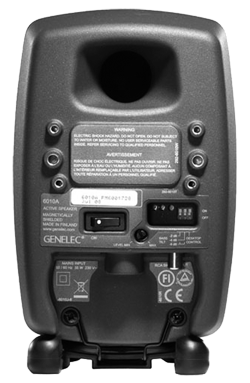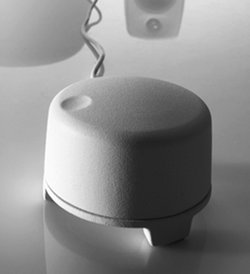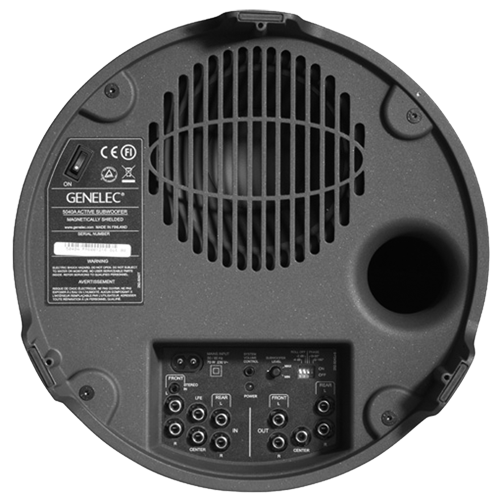by Steve Cunningham
I won these little speakers in a poker game. Right, I knew you wouldn’t believe me but it’s true, and I’ve decided to review ‘em this month. See, ninety-nine percent of the time getting a product for a RAP review is a process of research, consultation, telephone calls, a little begging, faxed memo loan forms, and waiting for UPS.
This time I just had to come in 15th out of about 70 Texas Hold ‘Em players at a charity tournament held at the Village Recorder. And my wife said I could go... honest, she really did, and I played well enough to walk out with a pair of company-donated Genelec 6010a speakers. Heck, if I hadn’t gone tilt at the featured table I might have won the Telefunken mic, but my emotions got to me, what can I tell ya? I took them home, and during the following week I went through the normal process of telephone calls, a little begging, memo loans and waiting to get the matching 5040a Subwoofer so I could check out the whole system. Meanwhile I went to work on my stereo prize.

NICE LITTLE SPEAKERS
When the hosts of the tournament first handed me the pair of smallish cartons, I wondered whether I was the proud owner of some really nice computer monitors or some very small studio monitors. It turns out that the Genelecs are a bit of both, with some caveats.
The 6010A is a rear ported, two-way, active monitor that can be used on its own, or in conjunction with the 5040A active subwoofer in stereo plus sub or 5.1 surround arrangement. Well below the price level of Genelec’s studio offerings, they’re priced to be attractive for high-end multimedia (read: computer) use, or for the small production studio that wants more panache than one usually gets in a low priced pair of speakers. This is not to say that the 6010A’s are cheap...
Genelec’s products have always had the Scandinavian design thing going on... their enclosures and “horns” (which they call Directivity Control Waveguides -- gotta love that marketing-speak) have for some time featured fewer sharp edges than other monitors, along with a very clean appearance and a perfunctory green LED embedded in the front.
 The 6010A loudspeakers stand just over 7-1/2” high with a 4-3/4” width and 4-1/2” depth, and each weighs in at just over three pounds. The housing is cast aluminum and is available in white, gray or charcoal gray (I got the charcoal, thank you). The design of the die-cast aluminum enclosure features Genelec’s Minimum Diffraction Enclosure (MDE) to reduce diffusion and internal resonance, and in the rear, a Directivity Control Waveguide (DCW) acts as a bass port to increase low end output. The free field frequency response (away from any walls) is rated from 74 Hz to 18 kHz (+/- 2.5 dB). A stereo pair is rated to produce 102 dB SPL peak output (in half space at 1 meter, with music program material).
The 6010A loudspeakers stand just over 7-1/2” high with a 4-3/4” width and 4-1/2” depth, and each weighs in at just over three pounds. The housing is cast aluminum and is available in white, gray or charcoal gray (I got the charcoal, thank you). The design of the die-cast aluminum enclosure features Genelec’s Minimum Diffraction Enclosure (MDE) to reduce diffusion and internal resonance, and in the rear, a Directivity Control Waveguide (DCW) acts as a bass port to increase low end output. The free field frequency response (away from any walls) is rated from 74 Hz to 18 kHz (+/- 2.5 dB). A stereo pair is rated to produce 102 dB SPL peak output (in half space at 1 meter, with music program material).
The 6010A’s two drivers consist of a 3/4” metal-dome tweeter and a 3” woofer, both of which are protected by individual perforated metal grilles. Each driver is fed by its own 12W amplifier in a bi-amped arrangement with a crossover at 3.0 kHz. Because the enclosure is curved, if you’re going to place the speaker on a flat surface you’ll need the included rubber foot assembly, called an Iso-Pod. This odd-looking device serves both to stabilize the speaker while also isolating it from the surface upon which it sits. If you prefer to wall-mount the speakers instead, you’ll find several tapped holes in the back of the cabinet for attaching an included wall-mount bracket. There’s even a hole in the bottom which appears to allow you to put it on a camera tripod.
Since the 6010A is intended for the prosumer market, the audio input connector on each speaker is an unbalanced RCA female with a 10k ohm impedance such as is provided by an iPod. Both the RCA jack and the power input next to it are mounted so that cables will hang down vertically, which is a nice touch. Above these connections on the rear panel are a power switch, a set of very small, screwdriver-operated level controls, and a set of even smaller DIP switches to adjust the bass frequency response. The latter provide up to 6dB of low-end cut (called “bass tilt”) to compensate for boundary effects, and an additional -4dB cut at 200 Hz to compensate for reflections and other frequency side-effects that arise when speakers are placed on either side of a computer monitor.
 A PAIR ALONE
A PAIR ALONE
When I got them out of their boxes and up on a meter bridge, I was first struck by the 6010A speakers’ diminutive size. Even sitting on their Iso-Pods, they were smaller than some low-end Logitek speakers I use at home. But they’re Genelecs, right? If you’ve been around for any length of time, you know that the Finnish company known as Genelec has been in the high-end studio monitor business for awhile (actually since 1978. And please note that Finnish means they’re located in Finland, right? Just checking.) In the US, Genelec have been a staple in high buck recording studios since the early 1980’s, when they became popular for mixing music, and later for film and TV work. But these are just so... small. How much cojones can I possibly get out of these little boxes? I plugged them in and turned on the power switch. The familiar green LED shown on the front panel. I hit play on the iPod and waited.
Okay, I’m impressed. Sure, the low end drop-off at 74 Hz is evident, especially on bass-heavy material, but danged if these don’t have the warm midrange and crisp high-end that I’ve always associated with Genelec. In fact, I have been of the opinion that Genelec’s are almost too bright in some cases, but not in this case. For small speakers these are really nice for music. With radio spots that consisted mostly of voiceover, I heard details that I hadn’t heard before, and I didn’t really miss the extreme low end. There’s enough high bass and low midrange to generate a bit of rumble when it was present in the mix. The rear reflex bass port does its job well, although it can’t amplify what the 3” driver can’t produce in the first place. Nonetheless, I think the 6010As are more than adequate for radio production work.
BOOM TIME
But eventually I did want to hear that last octave, and that’s when the 5040A sub showed up at the door. It’s an odd-looking beast, resembling a throw-pillow on steroids or some such, but in reality that pillow contains a down-firing 6-1/2” subwoofer with a cast-aluminum dome. Standing about 10” high and 12” in diameter, the 5040A weighs just under 14 pounds. Inside there is a 40 W internal amp driving the woofer, and producing a frequency response that is rated from 35 Hz to 85 Hz and will produce 98 dB SPL (played in half space at one meter, using short term sine waves).
 All the 5040A’s controls and connections are on the bottom. It incorporates a full bass management system for 5.1 surround, including a proper LFE input. A stereo mini jack and an RCA pair accommodate the front channel input, and both can be used simultaneously. All other inputs and outputs utilize RCA jacks, save for an additional 1/8” mini jack for the strange wired volume control supplied with the 5040A.
All the 5040A’s controls and connections are on the bottom. It incorporates a full bass management system for 5.1 surround, including a proper LFE input. A stereo mini jack and an RCA pair accommodate the front channel input, and both can be used simultaneously. All other inputs and outputs utilize RCA jacks, save for an additional 1/8” mini jack for the strange wired volume control supplied with the 5040A.
This control is finished in a die-cast housing shaped exactly like the 5040A in miniature. The sub is designed to take advantage of boundary effect from the floor and nearby walls, but it has the same “bass tilt” controls as does the 6010A.
Connecting the 5040A to the 6010As as a simple 2.1 system was easy enough, apart from the fact that you have to up-end the sub every time you need to adjust a control. Also, the volume control is too cute by half -- while there’s an indent so you can rock it like a scrub wheel, there are no position indicators so I had to put it out of the way lest my bass balance change. The only other issue was the somewhat unsightly group of cables growing out from under the sub like so many roots, but I suppose that’s to be expected.

I very much liked having that extra octave or two of music, although in the end I dialed the sub level down much further that I would have expected to, given the sharp drop-off in low end of the 6010As. Do you need to consider the sub for radio production work? No, I don’t think so... there’s just not that much useful information below 70 Hz, save some of the explosions and zaps that are falling out of favor anyway.
WRAP IT
I’d say I’ve had a good month. I played a little poker, got a very nice set of small monitors for my trouble, and the charity event raised over $7,000 for the Sound Art, an organization that provides a musical education in schools and community centers in urban LA... always a good thing.
Are the Genelecs appropriate for your production room? That depends on whether your budget can handle a pair of small speakers that street around $700 in the US. If you decide to get the sub as well, you can add another $600 street price to the package. I don’t think I’ll keep the sub, but the speakers are totally radio-production-worthy, and they are Genelecs. Check ‘em out.
The Genelec 6010A speakers carry a US suggested list price of $375 each, while the 5040A subwoofer’s suggested list is $750. For more information worldwide, visit www.genelec.com.
SIDEBAR: REDUCING BOUNDARY EFFECTS
Genelec includes a little six-page manual with each 6010 speaker, which is more than adequate to explain their use. A bonus is a setup guide that shows you how to place your speakers in your room to minimize speaker boundary effect. The bass “tilt” switches, mentioned elsewhere, also serve to tame speaker boundary effect, allowing you to reduce the bass output to suit your speaker placement. But what is speaker boundary effect and why does it need taming?
Speaker boundary effect is defined as the increase in bass response you get from placing a full-range loudspeaker on or very near a large flat surface -- a floor, wall, or ceiling. The flat surface acts as an extension of the speaker cabinet as the speaker and the flat surface acoustically couple with one another. This property increases the total bass output by 3 dB per surface. Allow me to illustrate.
You can try a simple experiment at home with one of your two stereo speakers, connected to your amp with a long speaker cable so you can move it around the room. Take that one loudspeaker and put it on a stool near the center of the room (disconnect the other so you hear just the one sound source). Listen to a piece of music you know well, and you should hear a reasonably accurate representation of that speaker’s ability to reproduce the music, since there are no large surfaces nearby to change the response. This is known as the free field response, and the speaker is said to be playing in a free field (as in no walls). Now set the speaker on the floor and listen again.
You should hear a slight increase in the bass level -- the actual increase is +3 dB -- that comes from playing the speaker in what’s called half-space. Next, put the speaker up against a wall while still on the floor and listen. You should hear a +6 dB increase in the bass, and since there are now two coupling surfaces the speaker is said to be playing in quarter-space. Finally, put the speaker on the floor in a corner, which will give you +9 dB of bass response as the loudspeaker plays in eighth-space coupled to three surfaces.
One way to improve the sound of your production room is to heed the lesson of speaker boundary effect. Try moving your speakers away from the back wall and see if that doesn’t make your productions sound less muddy. Keep in mind that if your speakers are sitting on your mixer’s meter bridge, the mixer surface itself will couple and add to the bass increase. This is why in most music mastering studios the monitors are on spindly stands, away from the back and side walls, in an effort to get them in close to free space.
♦

